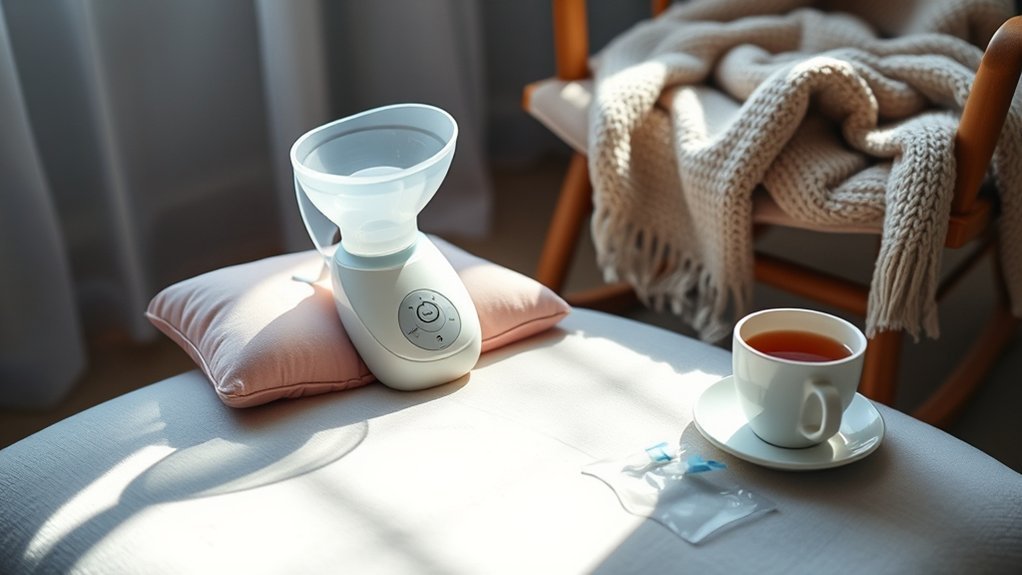If you’re exclusively pumping, you might experience a range of symptoms that can be challenging. Sore nipples, engorgement, and feelings of isolation are just a few signs that something might be off. It’s important to recognize these issues early on. Understanding what you’re facing can help you navigate this journey more smoothly. Let’s explore these common symptoms and how they can impact your pumping experience.
Physical Discomfort and Pain
When you’re exclusively pumping, it’s common to experience physical discomfort and pain, especially in the early days. Your body is adjusting to a new routine, and this can lead to sore nipples, engorgement, or even muscle strain from repetitive motions.
It’s important to listen to your body and take breaks if you need them. Using a properly fitted breast shield can make a world of difference, reducing friction and discomfort.
Additionally, applying a warm compress before pumping can help ease tension. Don’t hesitate to reach out to a lactation consultant if the pain persists; they can offer valuable advice tailored to your situation.
Decreased Milk Supply
Decreased milk supply can be a frustrating challenge for those exclusively pumping.
It’s important to remember that you’re not alone, and there are ways to address this issue. Here are three common reasons you might experience a decrease in milk supply:
- Inconsistent pumping schedule: Regular pumping helps stimulate milk production. Aim for a consistent routine.
- Insufficient hydration and nutrition: Your body needs proper hydration and nutrients to produce milk. Make sure you’re eating well and drinking enough fluids.
- Stress and fatigue: High levels of stress can affect milk supply. Prioritize self-care and rest whenever possible.
Emotional Challenges and Stress
While charting the journey of exclusive pumping, you might find yourself facing emotional challenges and stress that can impact both your well-being and milk supply.
The pressure to maintain a consistent pumping schedule can feel overwhelming, and it’s common to experience feelings of isolation or frustration. Acknowledge these emotions; they’re valid and shared by many.
Surround yourself with supportive friends or join online communities where you can connect with others in similar situations. Remember to take breaks for self-care, whether it’s a short walk or indulging in a hobby.
Prioritizing your mental health not only benefits you but also positively affects your milk production. You’re doing your best, and every drop counts, so be gentle with yourself during this journey.
Skin Irritation and Nipple Damage
As you navigate the challenges of exclusive pumping, skin irritation and nipple damage can become unwelcome companions on your journey.
It’s important to recognize these issues early on to prevent further discomfort. Here are three ways to help manage and alleviate irritation:
- Use a high-quality lanolin or nipple cream: This can provide a protective barrier and soothe existing irritation.
- Adjust your pumping routine: Make sure you’re not pumping too frequently or for too long, as this can exacerbate damage.
- Wear breathable, supportive nursing bras: This helps reduce friction and promotes healing.
Equipment-Related Issues
When you’re exclusively pumping, equipment-related issues can be a significant source of frustration that disrupts your feeding routine.
Whether it’s a faulty pump, worn-out flanges, or difficult-to-clean parts, these problems can add unnecessary stress to your experience. Regularly check your equipment for wear and tear; replacing parts as needed can help maintain a smooth pumping process.
If you notice decreased milk output or discomfort, it might be time to reassess your flange size or pump settings. Don’t hesitate to reach out to a lactation consultant for personalized advice.
Frequently Asked Questions
How Often Should I Pump for Exclusive Pumping?
You should pump every two to three hours, aiming for about eight to twelve times a day. This helps maintain your milk supply while ensuring your baby receives the nourishment they need. You’ve got this!
Can I Exclusively Pump if I Have a Low Milk Supply?
Yes, you can exclusively pump with a low milk supply. It may require extra effort and support, but many find ways to increase production. Don’t hesitate to reach out for help and resources along your journey.
What Are the Nutritional Considerations for Exclusively Pumped Milk?
Think of your pumped milk as a treasure chest. It’s essential to guarantee it’s rich in nutrients. Focus on a balanced diet, stay hydrated, and consider supplements to enhance your milk’s quality for your baby’s health.
How Can I Maintain My Pump Equipment Effectively?
To maintain your pump equipment effectively, clean all parts after each use, inspect for wear, and store in a cool, dry place. Regularly replace any worn items to guarantee peak performance and hygiene. You’ve got this!
Is It Normal to Feel Isolated When Exclusively Pumping?
Yes, it’s normal to feel isolated when you’re exclusively pumping. Many experience this. Connecting with other parents or joining support groups can help you feel less alone and provide encouragement during your pumping journey.
Conclusion
Exclusive pumping can be a challenging journey, but recognizing the signs and symptoms is essential for your well-being. You’re not alone in facing physical discomfort, emotional stress, or equipment issues. By addressing these challenges early on and seeking support, you can create a more positive experience for yourself and your baby. Remember, it’s okay to ask for help and make adjustments to your routine. Your commitment to providing nourishment is commendable, and self-care is just as important.
